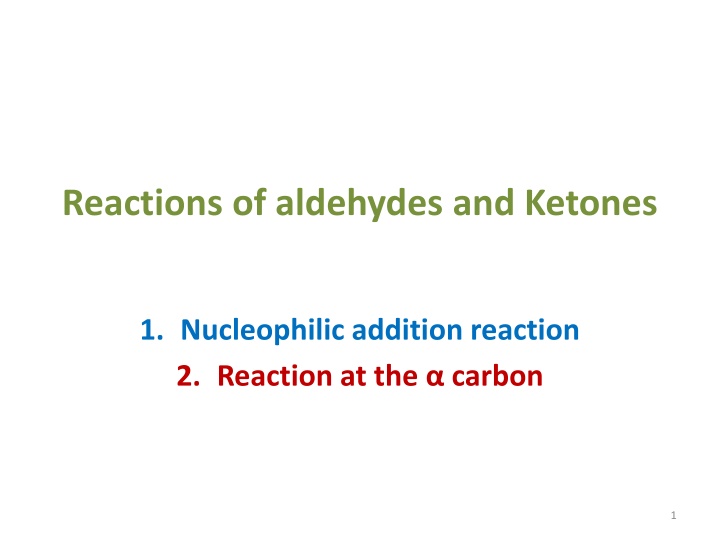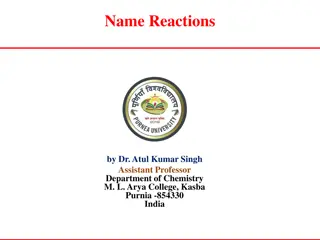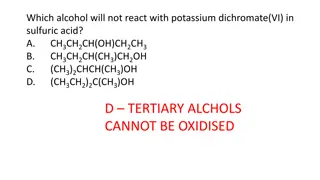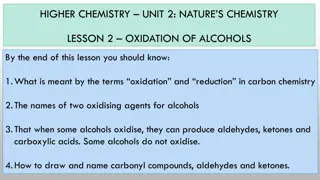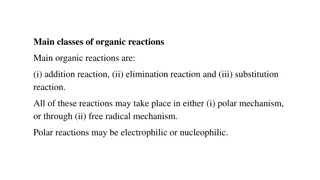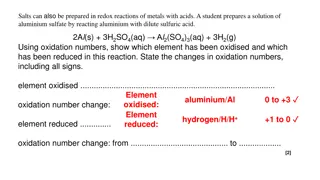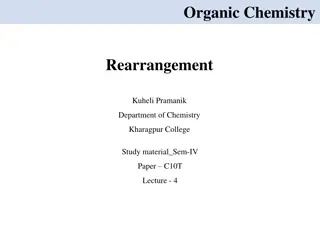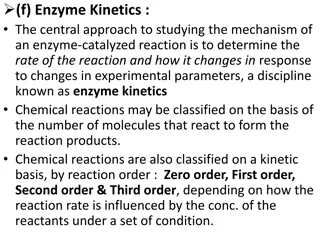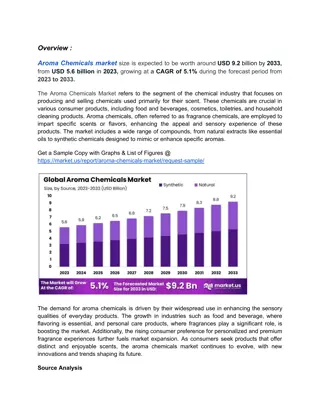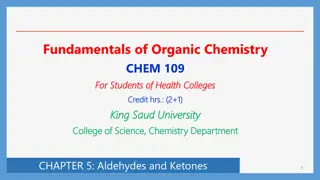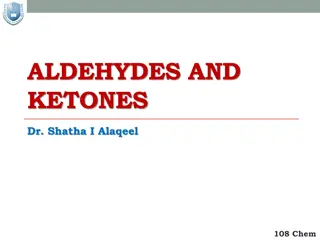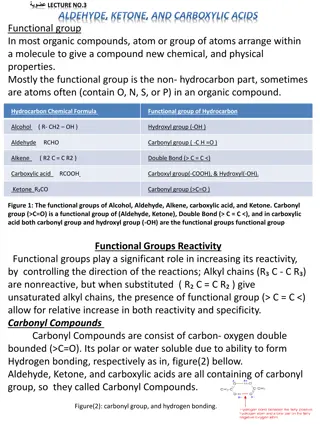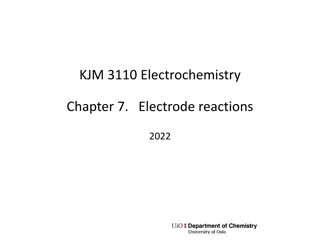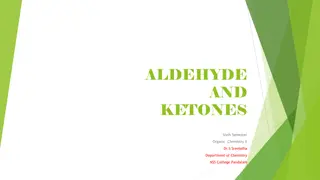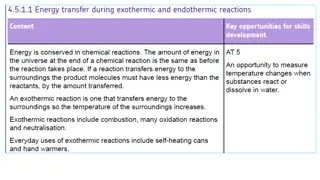Reactions of aldehydes and Ketones
Aldehydes and ketones undergo various reactions including oxidation to carboxylic acids, reduction to alcohols, and nucleophilic addition reactions such as cyanohydrin formation. Different reagents and conditions lead to specific products, showcasing the versatility of these functional groups.
Download Presentation

Please find below an Image/Link to download the presentation.
The content on the website is provided AS IS for your information and personal use only. It may not be sold, licensed, or shared on other websites without obtaining consent from the author.If you encounter any issues during the download, it is possible that the publisher has removed the file from their server.
You are allowed to download the files provided on this website for personal or commercial use, subject to the condition that they are used lawfully. All files are the property of their respective owners.
The content on the website is provided AS IS for your information and personal use only. It may not be sold, licensed, or shared on other websites without obtaining consent from the author.
E N D
Presentation Transcript
Reactions of aldehydes and Ketones 1. Nucleophilic addition reaction 2. Reaction at the carbon 1
Aldehydes & ketones, reactions: 1. Oxidation 2. Reduction 3. Nucleophilic addition reaction a) Addition of cyanide b) Addition of derivatives of ammonia c) Addition of alcohols d) Cannizzaro reaction e) Addition of Grignard reagents 4. Reaction at the carbon a) Alpha-halogenation of ketones b) Addition of carbanions 2
1) Oxidation Aldehydes are readily oxidized to yield carboxylic acids; but ketones are generally inert toward oxidation. Many oxidizing agents, including KMnO4, CrO3 in aqueous acid and hot HNO3, convert aldehydes into carboxylic acids. hot HNO3 KMnO4 RCHO or ArCHO RCOOH or ArCOOH K2Cr2O7 Oxidation of an aldehyde can be carried out using a solution of silver oxide (Ag2O) in aqueous ammonia, the so-called Tollen's reagent. Oxidation of aldehyde is accompanied by reduction of silver ion to free silver (in the form of a mirror under the proper conditions). O + Ag(NH3)2+ + 3OH- Colorless solution 2Ag + CH3COO- + 4NH3 + 2H2O Silver mirror C H H3C Methyl ketones: Oxidation of ketones required breaking of C C bond next to the carbonyl group and takes place only under vigorous conditions, except for methyl ketones which oxidized smoothly by mean of hypohalite (NaOX) to form Haloform (Haloform reaction). O + OI- O RCCH3 + CHI3 RCO- iodoform Yellow ppt 3
2) Reduction: To alcohols: aldehyde can bre reduced to 1 alcohol , and ketone to 2 alcohol , either by catalytic hydrogenation or by use reducing agent [Sodium borohydride (NaBH4) or Lithium hydride (LiAlH4) followed by protonation]. OH O H2, Ni C H C NaBH4 or LiAlH4 then H+ H2, Pt H H2, Pt O O C CH2OH OH H cyclopentanol cyclopentanone benzaldehyde benzyl alcohol OH 1. NaBH4 O CH3 CH3 LiAlH4 H+ CHCH3 C CH3 CH3CHCH2OH CH3CHCH=O 2. H+ isobutyraldehyde 1-phenylethanol isobutyl alcohol acetophenone 4
To hydrocarbons I. Clemmensen reduction: The Clemmensen reduction is most commonly used to convert acylbenzenes (from Friedel-Crafts acylation) to alkylbenzenes O H H C C CH2CH2CH3 CH2CH2CH3 Zn(Hg), CH3CH2CH2COCl conc. HCl AlCl3 n-Butyrophenone n-Butylbenzene II. Wolff Kishner reduction: The ketone or aldehyde is converted to its hydrazone, which is heated with Hydrazine (NH2NH2), and strong base such as KOH. O H H C C C(CH3)3 C(CH3)3 NH2NH2 + OH- Summary: Zn(Hg), conc. HCl Clemmensen reduction for compounds sensitive to base C H O H NH2NH2, base Wolff-Kishner reduction C H 5 for compounds sensitive to acid H
3) Nucleophilic addition reaction. I. Addition of cyanide: Treatment of an aldehyde or ketone with NaCN and a strong acid such as HCl adds the elements of HCN across the carbon oxygen bond, forming a cyanohydrin. O 1. CN- OH C CN C 2. H+ cyanohydrin OH O + NaCN; then H+ CN Cyanohydrins have two functional groups plus one additional carbon. Nitriles can be hydrolyzed to carboxylic acids in acid or base OH OH H2O, OH- heat COO- C N CH2CH CH2CH OH H2O, H+ heat C N C H C H COOH CH2CH 6
II. Addition of Alcohols (Acetal Formation): Aldehydes and ketones react with two equivalents of alcohol to form acetals. In an acetal, the carbonyl carbon from the aldehyde or ketone is now singly bonded to two OR" (alkoxy) groups. OR O + ROH, H+ C OR C acetal OH C OR hemiacetal OEt (xs) EtOH, H+ CH2CH CH2CHO OEt acetal OCH3 OCH3 (xs) CH3OH, dry HCl O 7 ketal
III. Addition of derivatives of ammonia (formation of imine): Treatment of an aldehyde or ketone with a 1 amine affords an imine (also called a Schiff base). Nucleophilic attack of the 1 amine on the carbonyl group forms an unstable carbinolamine, which loses water to form an imine. The overall reaction results in replacement of C=O by C=NR. 8
CH2CHO + H2NOH hydroxylamine CH2CH NOH an oxime phenylacetaldehyde H+ O O O NHNCNH2 + H2NHNCNH2 semicarbazide cyclohexanone a semicarbazone CH3CH2CH2CH2CHO + pentanal CH3CH2CH2CH2CH N NH NH2 NH a phenylhydrazone phenylhydrazine 9
IV. Cannizzaro reaction. (self oxidation/reduction) : In the presence of concentrated alkali, aldehydes containing no -hydrogen undergo self-oxidation and reduction to yield a mixture of an alcohol and a salt of a carboxylic acid. This reaction is known as the Cannizzaro reaction. H strong base 2 COO- Acid salt + CH2OH Alcohol C O An aldehyde with no hydrogen H 50% NaOH 2 H COO- Formate ion + CH3OH Methanol H C O room temp. Formaldehyde CrossedCannizzaro reaction: If two different aldehydes with no -hydrogen undergo Cannizzaro reaction yield a mixture of products. This reaction is called crossedCannizzaro reaction. conc. NaOH ArCHO + HCOH ArCH2OH +HCOO- Na+ Formaldehyde is the most easily oxidized aldehyde. When mixed with another aldehyde that doesn t have any alpha-hydrogens and conc. NaOH, all of the formaldehyde is oxidized and all of the other aldehyde is reduced. 10
V. Addition of Grignard reagents: The addition of Grignard reagents to aldehydes and ketones yields alcohols. The organic group, transferred with a pair of electrons from magnesium to carbonyl carbon, is a powerful nucleophile. O MgBr O + RMgX C R C O MgBr OH + Mg(OH)Br + H2O C R C R larger alcohol Synthesis of alcohols, used to build larger molecules from smaller organic compounds. O H+ RCH2OH 1o alcohol + 1 C RMgX +HCH formaldehyde RCH2OMgX H+ O R'CHOH RMgX + R'CHOMgX CH R' R R other aldehydes 2o alcohol + X C's 11
O CH3 H2O CH3CH2CH2CH2 C CH3 CH3CH2CH2CH2MgBr + CH3CCH3 OH 2-Methyl-2-hexanol or O CH3 H2O CH3CH2CH2CH2 C CH3 CH3CH2CH2CH2CCH3 + CH3MgBr OH 2-Methyl-2-hexanol Mg Br2,Fe Br MgBr OH H2O C CH3 CH3 OH CrO3 O 2-phenyl-2-propanol CH3CHCH3 CH3CCH3 12
4) Reaction at the carbon I. Alpha-halogenation of ketones: When a ketone is treated with a halogen and base, an -halogenation reaction occurs. 13
II. Addition of carbanions : Aldol condensation: Under the influence of or, two molecules of an aldehyde or a ketone, which, may combine to form a -Hydroxy aldehyde or -Hydroxy ketone. This reaction is called the Aldol condensation. 14
OH dil. NaOH CH3CHCH2CH O 3-hydroxybutanal CH3CH=O acetaldehyde OH O O dil. NaOH CH3CCH2CCH3 CH3 4-hydroxy-4-methyl-2-pentanone CH3CCH3 acetone The Aldol Reaction Dehydration of the Aldol Product Under the basic reaction conditions, the initial aldol product is often not isolated. Instead, it loses the elements of H2O from the and carbons to form an , -unsaturated carbonyl compound. 15
If aldehyde or ketone does not contain an -hydrogen, a simple Aldol condensation cannot take place. ArCHO HCHO (CH3)3CCHO ArCOAr ArCOCR3 dilute OH- No reaction No -hydrogen atoms 16
Wittig Reaction (C=O into C=C ): The synthesis of an alkene from the reaction of an aldehyde or ketone and a phosphorus ylide (Wittig reagent). CH3 CH3 C O (C6H5)3P=C(CH3)2 (CH3)2CHCH2CCH3 (CH3)2CHCH2CCH3 + (C6H5)3P=O 17
